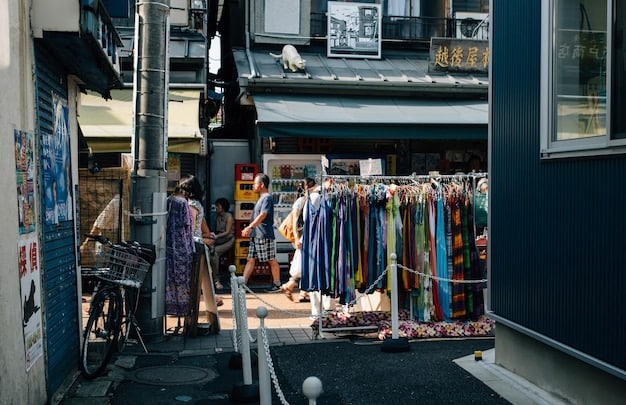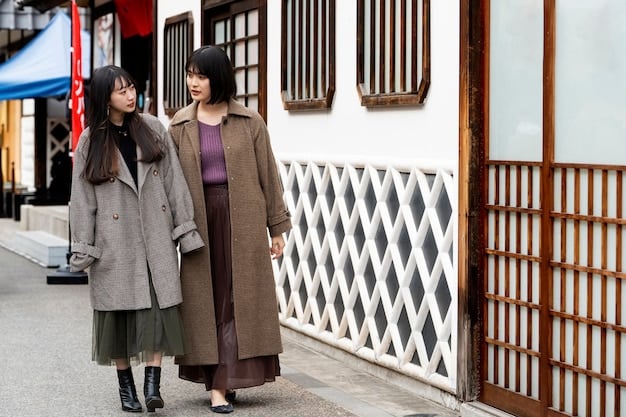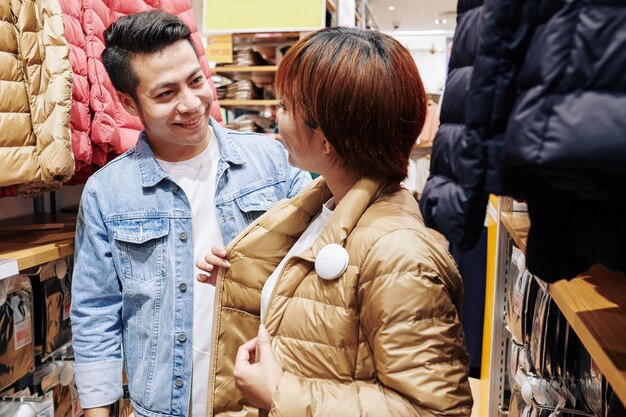Japanese Secondhand Shopping: A Guide for US Treasure Hunters

Japanese secondhand shopping offers US visitors a unique opportunity to find affordable, rare, and culturally significant items, from vintage kimonos to electronics, providing an immersive and sustainable shopping experience.
For US visitors, exploring Japanese secondhand shopping offers a thrilling adventure into a world of unique finds and incredible deals. From vintage fashion to electronics and traditional crafts, Japan’s secondhand scene is a treasure trove waiting to be discovered.
A Beginner’s Guide to Japanese Secondhand Shopping for US Visitors
Japanese secondhand shopping provides a fascinating glimpse into the country’s culture and history, offering an array of unique items. For US visitors unfamiliar with the local nuances, this guide will help navigate the secondhand market effectively.
Secondhand shopping in Japan is not just about finding cheap goods; it’s about discovering quality items with unique stories and histories. Knowing where to look and what to expect can greatly enhance your shopping experience.
Understanding the Japanese Secondhand Market
The Japanese secondhand market, known as “中古市場” (chūko ichiba), is well-organized and offers a wide variety of goods. Unlike some Western countries where secondhand shopping might imply lower quality, in Japan, items are typically well-maintained and carefully curated.
- Quality Control: Japanese secondhand stores are known for their stringent quality control. Items are often in excellent condition.
- Inventory Variety: From designer clothes and accessories to electronics and home goods, the inventory is diverse.
- Seasonal Sales: Keep an eye out for seasonal sales, offering even greater discounts.
Knowing these key aspects helps set expectations and allows shoppers to dive into Japanese secondhand shopping prepared for a rewarding experience.
In conclusion, understanding the basics of the Japanese secondhand shopping market can turn a simple shopping trip into an extraordinary cultural experience, revealing hidden gems and unique finds that are hard to come by anywhere else.
Top Spots for Secondhand Shopping in Japan
Knowing where to shop is crucial when exploring Japanese secondhand shopping. Different areas offer different types of goods and shopping experiences. Here are some top spots in Japan:
These locations are known for their unique selections, whether you’re hunting for vintage clothing, electronics, or traditional crafts. Each destination offers a distinct shopping experience that highlights Japanese culture.

Tokyo’s Hotspots
Tokyo is home to several famous areas for secondhand shopping:
- Shimokitazawa: Known for its bohemian vibe and vintage clothing stores, perfect for fashion enthusiasts.
- Harajuku: Offers a mix of trendy and vintage fashion, appealing to younger shoppers.
- Shibuya: Famous for its large department stores with secondhand sections, catering to varied tastes.
These districts provide a wide range of options, suitable for different tastes and budgets. Exploring these hotspots provides a rich cultural experience.
Navigating Tokyo’s secondhand scene can uncover incredible deals and rare finds, giving shoppers a taste of Japan’s unique style and culture.
Decoding Price Tags and Finding Hidden Gems
Understanding how pricing works and identifying valuable items are essential skills for Japanese secondhand shopping. Knowing the worth of items and negotiating prices appropriately can lead to significant savings.
Effective price decoding and discerning quality can help you secure the best deals and uncover unique treasures. This knowledge is invaluable for both casual shoppers and serious collectors.
Tips for Evaluating Items
Here are some simple steps to evaluate the quality and value of items:
- Check for Imperfections: Inspect items for stains, tears, or damage.
- Compare Prices: Use online resources to compare prices and assess the true market value.
- Ask Questions: Don’t hesitate to ask store staff about the item’s history or condition.
These techniques provide shoppers with the confidence to make informed decisions, ensuring they get the most value for their money.
In short, mastering the art of evaluating and pricing items is vital for a successful Japanese secondhand shopping adventure, enabling shoppers to find extraordinary value and unique pieces.
Navigating Language Barriers: Essential Phrases for Shopping
Language can be a barrier for US visitors, but learning essential phrases can enhance the shopping experience in Japan. Simple conversational skills can create smoother interactions and better deals.
Knowing a few key phrases can improve communication and foster goodwill, making shopping more enjoyable and effective. Language skills demonstrate respect for local culture and customs.
Useful Phrases for Shopping
Here are some phrases to help you get started:
- “Kore wa ikura desu ka?” (これはいくらですか?): “How much is this?”
- “Sukoshi makete moraemasu ka?” (少し負けてもらえますか?): “Can you give me a discount?”
- “Arigato gozaimasu” (ありがとうございます): “Thank you.”

Practicing these phrases can significantly improve your interactions, leading to more positive experiences and better deals. Simple courtesy goes a long way in Japanese culture.
In effect, arming yourself with basic Japanese phrases not only makes Japanese secondhand shopping easier but also enriches your cultural immersion, ensuring a more enjoyable and fruitful experience.
Payment Methods: Cash, Cards, and Digital Options
Understanding available payment methods is essential for efficient Japanese secondhand shopping. Japan’s payment landscape is diverse, with a mix of traditional and modern options.
Knowing your payment options can prevent unexpected issues and streamline transactions. Being prepared with the appropriate payment method ensures a smooth and pleasant shopping experience.
Popular Payment Methods in Japan
Here’s what you need to know about payment options:
- Cash: Still widely accepted, especially in smaller shops and markets.
- Credit Cards: Becoming more common, but not universally accepted.
- Digital Payments: Options like Suica, Pasmo, and PayPay are gaining popularity.
Being prepared with multiple payment methods ensures you can complete your purchases without hassle. It’s always a good idea to carry some cash as a backup.
Ultimately, understanding and adapting to Japan’s varied payment methods is vital for seamless Japanese secondhand shopping, allowing you to focus on discovering unique treasures without payment-related interruptions.
Sustainable Shopping: Contributing to a Greener Japan
Choosing Japanese secondhand shopping contributes to sustainable practices, supporting environmental conservation. Buying secondhand reduces waste and conserves resources.
Sustainable shopping aligns with global efforts to reduce environmental impact. By choosing secondhand, shoppers can promote a circular economy and minimize their carbon footprint.
Environmental Benefits of Secondhand Shopping
Here’s why secondhand shopping is eco-friendly:
- Reduces Waste: Extends the lifespan of products, decreasing landfill waste.
- Conserves Resources: Reduces the need for new production, saving energy and raw materials.
- Supports Ethical Consumption: Encourages mindful purchasing and reduces consumerism.
By participating in Japanese secondhand shopping, you contribute to a more sustainable and environmentally conscious society. You’re supporting practices that benefit both the planet and local communities.
In summary, embracing sustainable shopping through Japanese secondhand shopping is not only economical but also environmentally responsible, supporting a greener future for Japan and the world.
| Key Point | Brief Description |
|---|---|
| 🛍️ Shopping Spots | Explore Shimokitazawa, Harajuku, and Shibuya for unique finds. |
| 💰 Price Decoding | Check quality, compare prices, and don’t hesitate to ask questions. |
| 🗣️ Language Tips | Learn basic phrases for smoother interactions and possible discounts. |
| 💳 Payment Options | Cash is still king, but cards and digital options are increasingly accepted. |
FAQ: Japanese Secondhand Shopping for US Visitors
▼
You can find a wide variety of items, including clothing, electronics, home goods, books, and even luxury items. Quality and condition are often very high.
▼
Yes, it’s generally safe. Japanese secondhand stores have strict quality control. Always test the item if possible and check the store’s return policy.
▼
While not always expected, it’s worth a try, especially if you’re buying multiple items. Politeness and respectful communication are key to successful bargaining.
▼
Yes, always be polite and respectful. Handle items with care, and avoid eating or drinking inside the stores. A simple “thank you” goes a long way.
▼
Popular options include Suica and Pasmo (mainly for transportation but accepted in some stores), as well as PayPay and Line Pay. Check for signs at the store.
Conclusion
Exploring Japanese secondhand shopping offers US visitors a unique and rewarding experience. From discovering hidden gems to embracing sustainable practices, navigating the secondhand market provides both cultural immersion and valuable finds. With the right knowledge and preparation, you can enjoy a treasure hunt while contributing to a greener Japan. Happy shopping!





